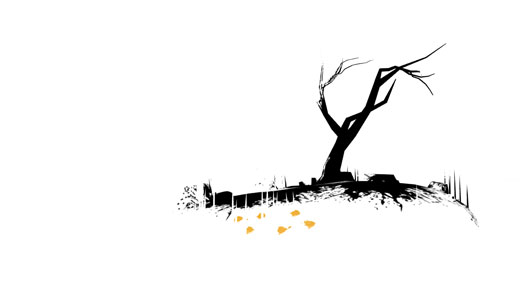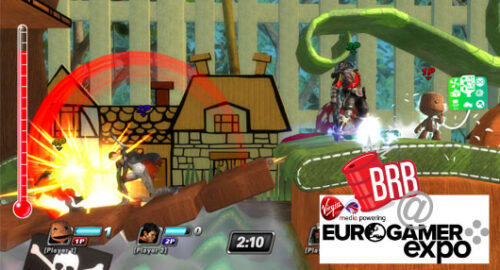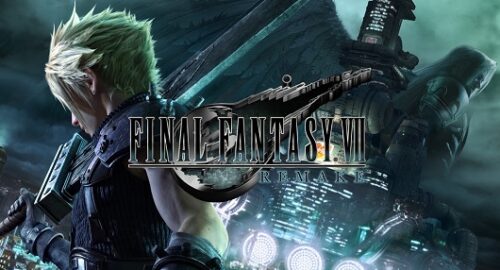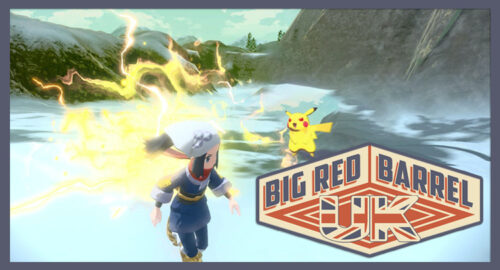When was the last time you felt lonely inside a game? I’m not talking about being ‘alone’: wandering through Skyrim or the Capital Wasteland by yourself isn’t lonely. Dead Space isn’t lonely – you’re definitely not alone there. For the first time, I’ve encountered genuine loneliness inside a game, of sorts. I’ve been playing The Unfinished Swan.
Available on the PlayStation Store for a week now – two if you’re subscribed to PlayStation Plus – TUS is a plaything which combines first-person control mechanics with a paint gun accessory and tasks you with finding your way around what is, at first, a completely white environment.
In the three hours or so that follow, the game unfolds as an interactive storybook more than a game. While both its nature and its conclusion will divide opinion, there’s something joyous about actually taking it in for yourself that you won’t find in other exercises in storytelling, such as Heavy Rain. It’s also a chance to encounter a pervasive loneliness the likes of which you won’t have found elsewhere in gaming.
Some spoilers follow.
Filling in the unfinished
The Unfinished Swan makes its intentions clear from the very beginning – it’s a tale of pure discovery, wrapped in a cloak of solitude. An opening cutscene, rendered with 2D hand-drawn art and narrated by the homely-sounding aunt of the game’s creative director, tells the story of Monroe – the player character – and his late mother, who loved to paint. She treasured, more than anything, an unfinished painting of a swan, and when the now-lonely Monroe awakes to find the swan missing he ventures out to find it, stepping into the completely white environment the game is already known for.
It’s not immediately apparent that you are in control. There are no loading screens between that establishing cutscene and the transition to gameplay, and the first time you press a shoulder button to let loose a ball of paint, it’s something of a shock. Black paint splattered across what was a canvas of white, it almost feels like you’ve dirtied something immutably pure.
At all times, you are left to guess at where you’re going, what you’re doing, or even where you are. Your only aid is the paint you can hurl at the world around you, sculpting stairs, stepping stones and statues out of the fog-like whiteness. You might even reveal a monstrously sized frog that grunts to life before you, leaping into the lake and leaving you to the white expanse again with a reverberating, deep splash. It’s a little spooky, weirdly scary, but totally in line with how Monroe is feeling. After all, wouldn’t you be on edge if you walked into a world in which everything is the purest shade of white?
The “interactive storybook” nature becomes hugely apparent as each moment of The Unfinished Swan unfolds. Telltale orange letters, boldly stamped on the environment in serif typeface, unfurl pages of the story when splatted, and the narrator’s warm American tones bring a little safety into the unfamiliarity. Until she runs out of words to say, anyway, leaving you to your own thoughts, the pure white of the ether, and the twinkles of the dreamy orchestral soundtrack.
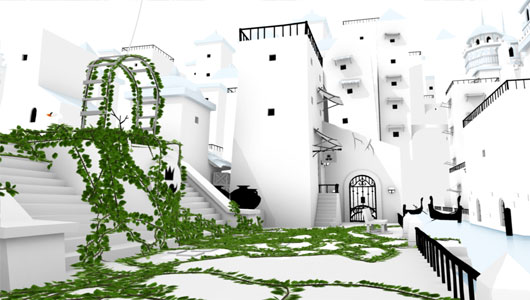
Meet your new best friend inside The Unfinished Swan.
You’ve got a friend
Between each of these sections, the actions you carry out feel like a drawn-out turn of the page, leading you into the next revelation or enthralling tidbit. The feeling of loneliness which creeps up on you as you play is there to help connect with Monroe, who doesn’t actually speak save for grunts when jumping and landing. To that end, any help you get in a game so deliberately mysterious almost feels like a friend – and so The Unfinished Swan‘s finer moments are the ones when you have a friend by your side. Of sorts.
The second chapter of the game takes place in a dazzling if distressed city, shadows bringing depth into the otherwise sparkling white world and giving you something to do other than scrabbling around with your eyes closed. To escape the metropolis, you must use watered-down paint to lure vines across the city’s landscape, turning walls into climbable surfaces. With a drop or two of paint the greenery sweeps to your aid, slithering across walls and floors with a shimmering sound, colouring the white walls with rich hues of emerald. As you leave the vines behind, it’s almost sad to see them go, to be on your own again. It was nice to have some sort of help for a while.
Later, the story even forces danger on you, as Monroe becomes lost in a dark forest in the third quarter of the game. Vicious spiders peer at you from the darkness with blood-red eyes and scuttle after you if you dare to step out of the light. A series of pulsating bulbs line the forest, their light a welcoming glow of safety, and darting between them while the creatures bear down on you is genuinely scary. After escaping the spiders, you find a house in the middle of the forest and inside…no. I can’t say. Not without ruining some of the game’s biggest surprises.
Surprise surprise
And that’s what The Unfinished Swan is: a very small, delightfully packaged surprise. It impresses with the mechanics it throws at you, and delivers a conclusion perhaps divisive in what it answers and what it doesn’t. A £10 asking price will probably split opinion just as much, but the box of tricks that the story has to show off is probably worth experiencing, if only to add to your repertoire of things that you’ve done inside a game. It does things that other games shouldn’t, and tells a story and encourages you to feel in ways that others don’t. It even makes you think. And for that, it should be commended.
